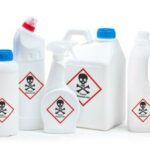Corrositex®: Testing & Classifying for Skin Corrosion
By Dana Mladin, B.SC. LABORATORY TECHNICAL SPECIALIST & REGULATORY AFFAIRS SPECIALIST
One of the test methods performed in Dell Tech’s lab is called Corrositex® (OECD 435) (hereinafter “Corrositex”). It is a type of corrosion testing used to evaluate corrosive substances for potential danger to human skin (also known as dermal corrosion).
Dell Tech performs Corrositex testing to assist clients with packing group determination, an important component of occupational safety and compliance with the Globally Harmonized System (GHS acceptance).
Many of Dell Tech’s Clients have been delighted to see their GHS classification go from 1A to 1B, 1C or non-corrosive. Read the full article to learn how Dell Tech can assist your company with skin corrosion testing.
We will cover the test method and how it works. But first, let’s look at corrosive substances and the regulations governing them.
What is a corrosive substance and what do regulations require?
A corrosive substance is defined as material that causes irreversible damage to the skin, namely, visible necrosis through the epidermis and into the dermis. This definition comes from several regulations, including:
- DOT Hazardous Materials Regulations
- OSHA HCS 2012
- Federal Hazardous Substances Act
- TDG Regulations
- Hazardous Products Regulations for compliance with WHMIS (HPR)
- Consumer Chemicals & Containers Regulations (CCCR)
- GHS
These regulations applicable to consumer products, workplace products, and transportation of hazardous materials require that the hazard classification be determined and that records supporting the hazard classification be maintained.
What is Corrositex and how does it work?
Corrositex is the lowest cost, fastest, and most accurate non-animal OECD/GHS approved corrosion test available.
Is Corrositex a validated OECD in vitro method?
Yes. Corrositex was validated and published in 2015 as OECD 435 In Vitro membrane Barrier test for Skin Corrosion.
Corrositex is specifically cited and accepted by the following:
- US DOT Hazardous Materials Regulations
- Canada Transportation of Dangerous Goods Regulations
- OSHA HCS 2012
- WHMIS Technical Guidance
- US EPA Method 1120
- Globally Harmonized System of Classification and Labeling of Chemicals (GHS)
Validated in vitro OECD methods cited and accepted by the following:
- Consumer Product Safety Commission Hazardous Substances Regulations
- Canada Consumer Chemicals and Containers Regulation
How does Corrositex testing work?
The Corrositex testing system consists of a glass vial filled with a chemical detection fluid capped by a proprietary bio-barrier membrane, which is designed to respond to corrosive chemicals in a manner similar to animal skin in situ.
The Corrositex test is performed in three steps.
- A qualification test is completed to ensure that the test sample and the CDS reagent are compatible. If a physical change or color change is observed, the sample is judged to be compatible with the detection solution, and the remainder of the test is performed.
- Appropriate indicator solutions are used to permit the categorization of the test sample as either a Corrositex Category 1 or Corrositex Category 2 material. Corrositex Category 1 materials are typically strong acids/bases, while Corrositex Category 2 materials are typically weak acids/bases.
- The test sample is applied to the biobarrier. When the chemical permeates through or destroys the full thickness of this biobarrier, it comes into contact with the CDS which then undergoes a simple color change. This color change is visually observed and the time required for the color change to occur is recorded.
Users simply record the time it takes for the sample to break through the membrane. Then, depending on their needs, they can assign the proper GHS Category and/or UN Packing Group classification for U.S. DOT, EPA compliance. The data can also be used as a ranking tool to substantiate marketing claims.
Does Corrositex require expensive or complicated equipment?
No, Corrositex testing does not require expensive or complicated equipment. The test uses standard laboratory equipment.
The equipment and materials that are required to perform Corrositex testing (but that are not included with kits) are:
- Stirrer Hot plate
- Analytical balance
- Thermometer
- Digital Timers (2)
- Eppendorf repeat pipettor
- Eppendorf combitips 2.5 mL
- Suitable container for water bath
- Refrigerator
- Plastic wrap
Does Corrositex require specialized training to perform?
No, Corrositex testing (OECD 435) does not require specialized training. Corrositex can be performed by people with common laboratory bench skills such as weighing and pipetting.
You can watch a demonstration video here
How fast can the Corrositex test be performed?
The Corrositex testing can easily be completed from start to finish within one workday (8 hours).
Is Corrositex animal testing?
No, Corrositex does not use animals. Unlike animal testing, it is an in vitro (test tube) method. Corrositex is considered one of the trusted alternative methods to animal testing for skin corrosion testing.
You can learn more about Canada’s proposed ban on using animal test methods for consumer products in an article published by our team here.
What are the advantages of using Corrositex?
Some of the advantages of using Corrositex testing are:
- Accurate hazard classifications and defensible data;
- A practical alternative to animal testing;
- Corrositex is a fraction of the cost of animal testing;
- Corrositex can reduce shipping costs for your company with properly classified materials;
- Quick results when the timing is critical; and
- The test can be performed by your staff at your facility.
Where can I buy Corrositex testing kits?
- Companies residing in the UNITED STATES must order Corrositex® kits from:
In Vitro International
800-2-INVITRO (800-246-8487)
- Companies residing in CANADA must order Corrositex® kits from:
Dell Tech Laboratories
519-858-5021
How Dell Tech can support you with Corrositex Testing
In addition to being the exclusive supplier of InVitro Corrositex® kits in Canada, Dell Tech is also the leading accredited Corrositex® testing lab in the country. It is one of the many test methods performed in our ISO 17025 accredited laboratory. Contact our team today to quote your Corrositex project.
Dell Tech has provided professional, confidential consulting services to the specialty chemical
industry in Canada, the USA, Europe, and Asia for the last 40 years.
Contact us today for more information.




